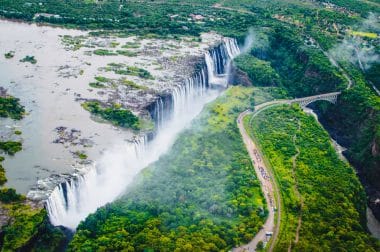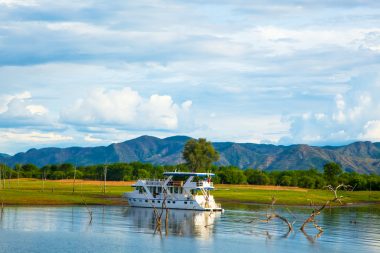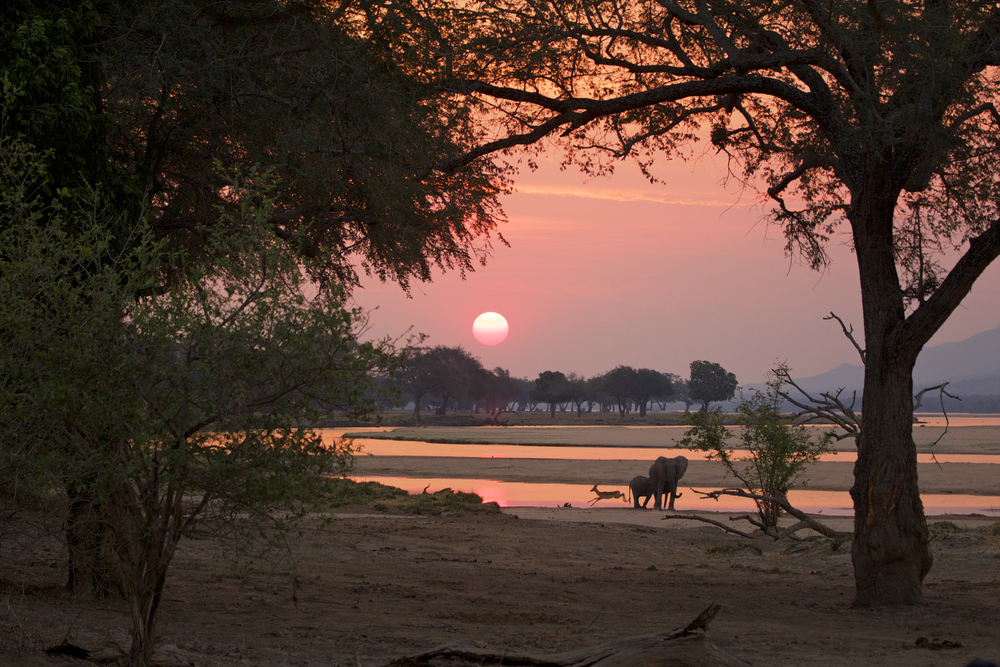Zimbabwe, a country in southern Africa, is known for its impressive landscapes, diverse wildlife, and rich history. The country’s famous Victoria Falls, magnificent national parks and cultural heritage make Zimbabwe a fascinating destination. Here is the most important information for an unforgettable holiday in Zimbabwe. The 390,000 square kilometre country in the heart of Africa has just as impressive wildlife as Kenya or Botswana and also some cultural monuments to offer.
Top attractions in Zimbabwe
Victoria Falls

Zimbabwe is home to one of Africa’s great natural sights, the Victoria Falls – even if only half: In the far northwest, the Zambezi forms the border with neighboring Zambia. Here the mighty river plunges 108 meters deep into the narrow Batoka Gorge. However, it is not only the height that makes this waterfall one of the most beautiful and impressive on earth, but also its width: the immense water cascade is more than 1700 meters wide. From February to May, the Zambezi reaches its highest water volume, the spray of the Victoria Falls can then be seen up to 50 kilometers away. No wonder that it is counted among the “seven natural wonders of the earth” by experienced travellers. If the mere sight of this natural spectacle is not spectacular enough, you can book a rafting tour on the Zambezi or a bungee jump.
Lake Kariba Zimbabwe

A little further east, the Zambezi flows into the elongated Lake Kariba. Even though this is not a natural lake – it was created after the construction of a dam in 1959 – it is considered one of Zimbabwe’s great attractions. With a length of 220 kilometres, it is one of the largest reservoirs in Africa, and even the largest artificial lake in the world in terms of its water volume. There are several luxurious lodges on its shores, but the best way to experience the lake is on a houseboat trip. Part of the southern shore of Lake Kariba belongs to the Matusadona National Park, one of Zimbabwe’s eleven national parks. Since the interior of the park is rather difficult to reach, such a boat trip is the best way to experience the fauna of the national park: crocodiles, black rhinos, elephants, giraffes and antelopes can be seen on the shores as well as countless bird species, including flamingos and ospreys.
Mana Pools National Park
Only a few hundred kilometers away, in the far north of the country, lies the Mana Pools National Park. It is considered one of Zimbabwe’s most pristine natural landscapes and is on the UNESCO Natural Heritage List. A visit is worthwhile for the high density of large African animals such as elephants, Cape buffaloes, leopards and chimpanzees. A special feature are the natural lakes formed by the Zambezi River, which gave the park its name and carry water even during the dry season. Many of Africa’s water-loving animals such as hippos and Nile crocodiles can be observed here, as well as countless bird species.
Hwange National Park
Located in the east of the country, on the border with neighboring Botswana, Hwange National Park is Zimbabwe’s oldest and, with almost 15,000 square kilometers, the largest protected area. Its fauna alone includes around 100 species of mammals, including, of course, all of the “Big Five” that you definitely want to see on a safari holiday: elephant, lion, leopard, rhinoceros and cape buffalo. In fact, the elephant population in Hwange is one of the largest in the world. But African wild dogs, hyenas and the highly endangered black rhinoceroses, which have become rare in many parts of Africa, can also be seen regularly in this national park. Accommodation in the national park ranges from simple tented camps to luxurious lodges with glamping character.
Bulawayo
But Zimbabwe not only has natural sights to offer, but also urban hotspots. While the capital Harare is not attractive for tourists, the country’s second largest city, Bulawayo, is well worth a detour: Many streets of the city consist of the typical British colonial architecture of the 19th century.
Great Zimbabwe National Monument

Another cultural attraction is the Great Zimbabwe National Monument, which is located a good 300 kilometers (almost around the corner by African standards) east of Bulawayo. These are the ruins of “Great Zimbabwe”, the capital of the historic kingdom of Zimbabwe. The buildings, whose ruins are spread over a large area, were built between the 11th and 15th centuries. It is the most important ruin site in sub-Saharan Africa. Even Chinese porcelain has been found here, proving the city’s status as a major trading center.
Matobo National Park
The Matobo National Park, located about 40 kilometers south of Bulawayo, is known less for its wildlife than for its extraordinary landscape: gently rounded granite rocks form a landscape that is rather unusual for Africa. Hidden between the rocks are San Bushman petroglyphs, which are several thousand years old. But that doesn’t mean that there are no animals to be seen here at all: Although there are neither lions nor elephants, there is one of the largest leopard populations in southern Africa.
Chimanimani National Park
In the far east of the country, on the border with Mozambique, the Chinamani National Park with its surprisingly green hilly landscape, its gorges and lush green valleys forms an interesting and invigorating contrast to the otherwise rather dry and barren African landscape. The park includes the Chimanimani Mountains and extends to neighboring Mozambique. The highest peak is the 2436-meter-high Monte Binga, which lies just across the border in Mozambique .
Chinhoyi Caves National Park
Another extraordinary natural attraction is the Chinhoyi Caves, which are protected by the surrounding national park. The Chinhoyi Caves are stalactite caves; about 50 meters below the surface is an 80 to 90 meter deep lake, the “Sleeping Pool”, which impresses with its water shining in an incredible blue.
Tips for a safari in Zimbabwe
A safari in Zimbabwe is a once-in-a-lifetime experience that combines breathtaking landscapes, fascinating wildlife sightings and authentic African culture. From the majestic Victoria Falls to the sprawling national parks and ancient ruins of Great Zimbabwe, the country offers a variety of adventures and discoveries. Here is the most important information for an unforgettable safari in Zimbabwe.
Best time to visit
- Dry season (May to October): The best time for safaris. Less vegetation and water sources mean better sightings of wildlife congregating around the remaining waterholes.
- Rainy season (November to April): Landscapes are green and lush, ideal time for bird watching, however, some roads are impassable and wildlife sightings can be more difficult.
Journey
- Airports:
- Victoria Falls Airport (VFA): Ideal for safaris in the national parks in the west of the country.
- Harare International Airport (HRE): Main airport from which many safari tours depart.
- Joshua Mqabuko Nkomo International Airport (BUQ): In Bulawayo, near the Matobo National Park.
- Road: Well-maintained roads connect the major cities and national parks, but 4×4 vehicles are recommended for more remote areas.
Important national parks and wildlife reserves
- Hwange National Park: The largest and most famous national park in Zimbabwe, home to a large elephant population as well as lions, leopards, buffaloes and many other animals.
- Mana Pools National Park: A UNESCO World Heritage Site, known for its unspoiled wilderness and excellent opportunities for canoe safaris and hikes.
- Matobo National Park: Famous for its spectacular rock formations, rhino sightings, and historical sites.
- Matusadona National Park: Located on the shores of Lake Kariba, this park offers excellent opportunities for boat safaris and game viewing.
- Gonarezhou National Park: A remote and less-visited area, ideal for adventurous safaris and known for its large elephant population.
Safari Accommodations
- Lodges: Luxury options with all the comforts, often located in the national parks, offer exclusive experiences and guided tours.
- Tented Camps: An authentic safari experience closer to nature. They often offer excellent service and guided activities.
- Self-catering camps: Ideal for independent travellers who want to create their own safari.
Activities and experiences
- Game Drives: Guided tours with experienced rangers offer the best chances of seeing and photographing wildlife.
- Walking safaris: Especially possible in Mana Pools and Matobo, these tours offer an intense nature experience.
- Boat safaris: A highlight especially on Lake Kariba and in the wetlands of Mana Pools.
- Cultural Tours: Visits to local villages and interactions with the communities offer insight into Zimbabwe’s culture and traditions.
- Birdwatching: With over 600 species of birds, Zimbabwe is an ornithologist’s paradise.
Safety
- Crime: Safaris in national parks are generally safe. However, in cities and busy areas, usual precautions should be taken.
- Health: Malaria prophylaxis is recommended for safari areas. Vaccinations against yellow fever, hepatitis A and B and typhoid fever should be up to date.
- Emergency number: 112
Important tips
- Tour guides: Use experienced guides and rangers for a safe and informative safari experience.
- Packing List: Light, breathable clothing in neutral colors, sturdy shoes, sun hat, sunscreen, insect repellent and binoculars are essential.
- Respect for nature: Stick to the rules of the national parks and respect wildlife. Do not leave any garbage behind and do not disturb the animals.
Holidays in Zimbabwe: The most important information
Journey
- Airports:
- Harare International Airport (HRE): The country’s main airport, about 15 km southeast of the capital Harare.
- Victoria Falls Airport (VFA): About 20 km from Victoria Falls, ideal for tourists who want to visit the falls.
- Joshua Mqabuko Nkomo International Airport (BUQ): In Bulawayo, Zimbabwe’s second largest city.
- Visas: Tourist visas are available upon arrival at the airport or can be applied for online in advance.
Important telephone numbers
- Police: 995
- Fire brigade: 993
- Ambulance service: 994
- General emergency: 112
- Tourist information: +263 4 748 697
Supermarkets
- TM Pick n Pay: Several branches in Harare and other major cities.
- OK Zimbabwe: Large supermarket chain with branches all over the country.
- SPAR: Various locations in the major cities.
- Food Lovers Market: In Harare and other urban areas.
Doctors and hospitals
- Harare:
- Parirenyatwa General Hospital: +263 242 708 761
- Health Point Clinic: +263 242 744 806
- Bulawayo:
- Mpilo Central Hospital: +263 29 226 0361
- United Bulawayo Hospitals: +263 29 226 0331
- Victoria Falls:
- Victoria Falls Hospital: +263 13 4201
Important words with translation
- Hello – Mhoro (Shona) / Sawubona (Ndebele)
- Thank you – Tatenda (Shona) / Ngiyabonga (Ndebele)
- Please – Ndapota (Shona) / Ngiyacela (Ndebele)
- Yes – Marriage (Shona) / Yebo (Ndebele)
- No – Kwete (Shona) / Hayi (Ndebele)
- Sorry – Pamusoroi (Shona) / Uxolo (Ndebele)
- Where is…? – Iri kupi…? (Shona) / Ikuphi…? (Ndebele)
- How much does it cost…? – Ingoi marii…? (Shona) / Kubiza malini…? (Ndebele)
- Emergency – Mamiriro ezvinhu akadzama (Shona) / Isimo esiphuthumayo (Ndebele)
- Doctor – Chiremba (Shona) / Udokotela (Ndebele)
- Hospital – Chipatara (Shona) / Isibhedlela (Ndebele)
Holidays
- New Year’s Day: January 1
- Independence Day: April 18
- Labour Day: 1 May
- Africa Day: May 25
- Heroes’ Remembrance Day: Second Monday in August
- Defense Forces Day: Second Tuesday in August
- Christmas: December 25
- Boxing Day: December 26
Opening hours
- Shops: Usually Monday to Friday from 8:00 a.m. to 5:00 p.m., Saturday from 8:00 a.m. to 1:00 p.m.
- Supermarkets: Usually daily from 8:00 a.m. to 8:00 p.m.
- Restaurants: Lunch from 12:00 to 14:30, dinner from 18:00 to 22:00.
- Banks: Monday to Friday from 8:00 to 15:00, Saturday from 8:00 to 11:00.
Things to see and do
- Victoria Falls: One of the largest waterfalls in the world, spectacular views and adventure activities such as bungee jumping and rafting.
- Hwange National Park: The largest national park in Zimbabwe with impressive wildlife, including elephants, lions and buffaloes.
- Mana Pools National Park: UNESCO World Heritage Site and paradise for wildlife viewing and canoe safaris.
- Great Zimbabwe: Archaeological ruins and UNESCO World Heritage Site, the testimony of an ancient African civilization.
- Matobo National Park: Well-known rock formations, historical sites and rhinos.
NUDISM
- Not common: There are no official nudist beaches or facilities in Zimbabwe. Nudism is not practiced and could be considered offensive.
Post / Stamps
- Post offices: In all major cities and towns. Main post office in Harare. Opening hours: Monday to Friday from 8:00 a.m. to 4:30 p.m., Saturday from 8:00 a.m. to 12:00 p.m.
- Stamps: Available at the post office and in some kiosks.
- Costs for letters and postcards to Germany: Standard letter up to 20g: approx. 2 USD; Postcard: approx. 1.50 USD
Safety
- Crime: Zimbabwe is considered relatively safe, but as in any country, you should be attentive. Beware of pickpockets and do not be alone in the evening hours.
- Emergency number: 112
Current
- Voltage: 220-240 volts
- Sockets: Type D and G. Adapters for European plugs are required.
Tip
- Restaurants: 5-10% of the invoice amount
- Taxis: Round up the amount
- Hotels: $1-2 per day for cleaning staff
Customs
- Allowances: Personal belongings are duty-free.
- Alcohol: Maximum 1 liter of spirits or 2 liters of wine.
- Tobacco: 200 cigarettes or 50 cigars or 250g of tobacco.
- Other items: Value up to $200 duty-free.

